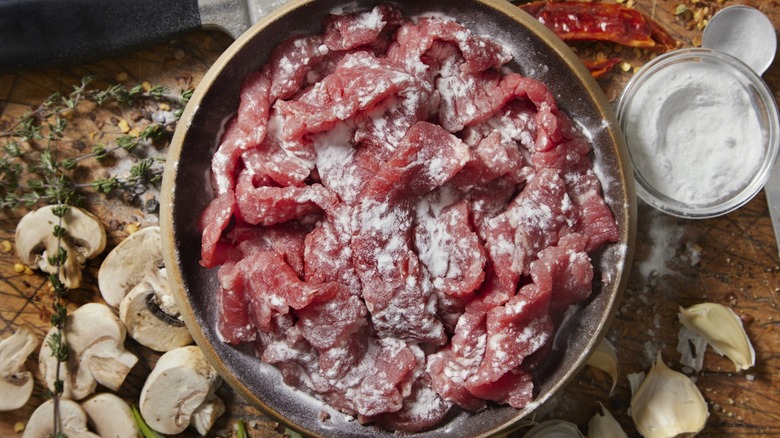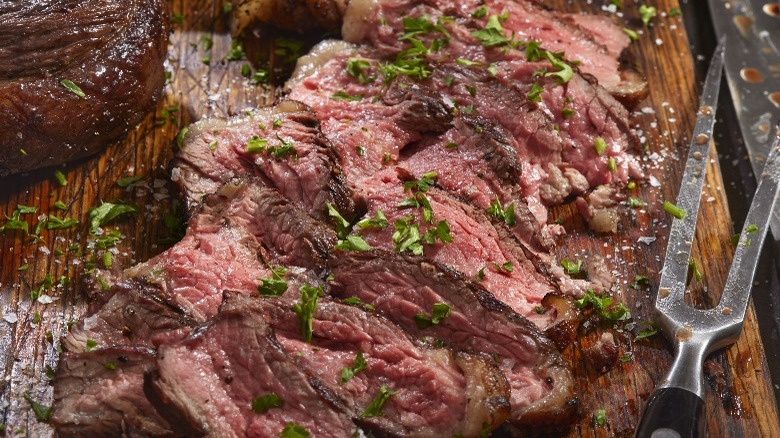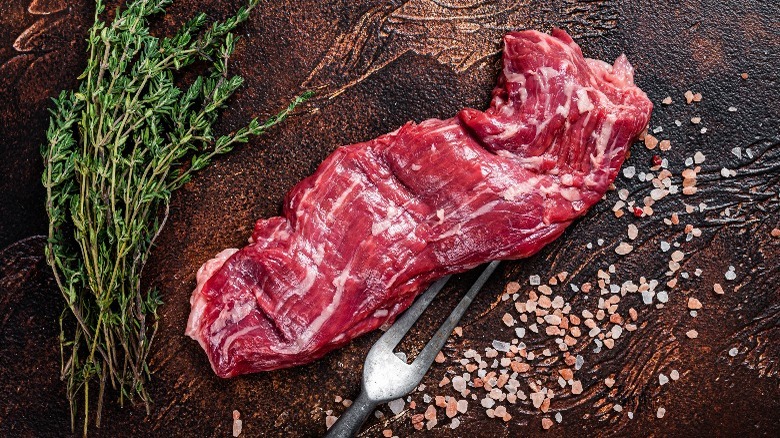How Does Meat Tenderizer Work?
It's a wholly unpleasant experience to bite into a piece of steak and feel like your teeth have to work like an industrial machine to grind up the pieces. That's why it's never a bad idea to tenderize your piece of meat depending on the particular cut. There's a broad array of methods to soften up your steak, including the meat tenderizer powder that you can find in your grocery store's spice aisle. But what exactly is this mysterious substance?
Not all meat needs to be tenderized, but the cheaper ones do. Generally speaking, a well-marbled steak is soft enough to bite into after just a bit of salt. The same goes for a leaner, albeit still tender cut, like a filet mignon. However, more muscly pieces like flank, skirt, chuck, sirloin, tri-tip, or eye-of-round benefit from a good pounding with a meat mallet. Tenderizer powder, however, is helpful if you're squeamish about the idea, or if you just don't have the energy for the back-and-forth of swinging a meat mallet.
Deciphering the tenderization process
The basic science of tenderization is all about loosening up and breaking down the collagen fibers that strengthen muscles. Whereas the spikes on a meat mallet loosen these bindings with sheer force, tenderizer powder works in subtler ways using enzymes called proteases that interact with the collagen. Bromelain and papain, which are naturally found in pineapple and papaya respectively, are two protease enzymes commonly found in the mixture that dissolve the tight chain of amino acids that form collagen (you can actually feel the effects of bromelain with the tingly taste of pineapple).
Pineapple and papaya also make for nice marinade ingredients, especially if you're looking for fruity flavor alongside a tenderer piece of meat. Figs, kiwis, and mangoes also contain similar protease enzymes and thus work as natural tenderizers. Other methods of tenderizing include using an acid-based marinade containing lemon, lime, or vinegar, or by simply adding a dash of salt or baking soda. Slow-cooking will also break down the collagen into softer pieces. Tenderizer powder, however, works more quickly, and is ideal in situations that require less seasoning and a faster cooking method, like grilling or pan-frying.
Advice for using meat tenderizers
The speediness of tenderizer powder's chemical reaction is both a blessing and a curse. Though convenient, tenderizer powder must be used judiciously. Leaving it on for more than a few minutes, or up to half an hour for an especially thick cut, risks over-tenderizing, potentially turning your meal into a less appetizing, gelatinous consistency. Cooking will immediately start to break down the muscle fiber proteins, so there isn't any more preparation you have to do after sprinkling the powder on. It also helps to poke some holes in your meat so the tenderizer can sufficiently seep in past the surface.
Some brands like McCormick sell seasoned powder that also contains salt and dried spices besides the main enzyme. If you want to infuse your meat with flavor on a deeper level, you'll have to remember to season it separately at least a couple of hours beforehand. Again, just be careful that whatever you're seasoning it with hasn't already made the meat tender enough, and only lightly sprinkle your meal with the powder afterward.



